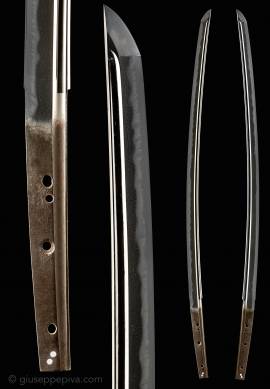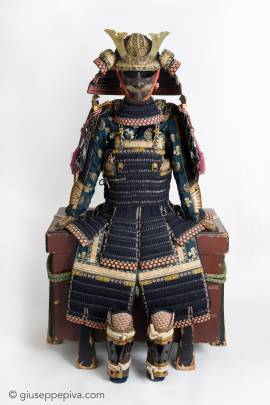YOSHIOKA ICHIMONJI KATANALate Kamakura PeriodMumei, circa 1320NBTHK Juyo TokenNagasa [length]: 66.8 cmSori: 1.6 cm, motohaba: 3.0 cm, sakihaba: 2.1 cmSugata [shape]: Shinogi-ø, iori-mune, tori-zori curvature with chu-kissakiKitae [forging pattern]: Ko-itame mixed with nagare hadaHamon [ltemper line]: Choji midare, sometime saka-choji, mixed with ko gunome, in nioi dekiHataraki [activities]: Koashi, yōBoshi [point temper line]: Notare komi with komaru.Nakago [...
WORKS FOR SALE
Rakuchū Rakugai ZuViews of Kyoto
Edo period, mid 17th century
Pair of six-panel folding screens; ink, colors, and gold on paper
Each 121 by 282 cm Folding screens depicting the ancient capital city of Kyoto and its surroundings (rakuchū rakugai zu) are among the most popular genres of Japanese painting. The broad surfaces of folding screens (byōbu) were ideally suited to the panoramic cityscape, as they afforded artists opportunities both to present sweeping vistas of the capital and to focus on details of everyday life in the city. Kyoto screens first appear in documents in the...
Samurai armourEdo period (1615-1867), 18th century SignatureThe menpō is signed under the chin 弘前住 明珍紀宗賢 盛吉作 (Hirosaki no Ju Myōchin ki Munekata Moriyoshi saku) CertificateThe armor accompanied by a certificate of registration as Jūyō Bunka Shiryō(Important cultural work)issued by the Nihon Katchu Bugu Kenkyu Hozon Kai (Association for the Research and Preservation of Japanese Helmets and Armor).Literature:Katchu Bugu Juyo Bunka Shiryo Zuroku - Vol. 4, (Tōken shunjû shinbunsha: Tōkyō, 2004), Pag. 76-77Description:The style of the armor is reminiscent of the medieval suits, as common...
Copyright © 2016 - giuseppe piva - VAT: 05104180962










